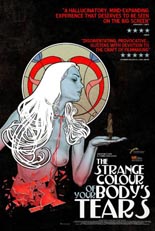
 Round and round goes the camera of Hélène Cattet and Bruno Forzani in The Strange Color of Your Body’s Tears, the filmmaking duo’s follow-up to 2009’s acclaimed Amer. The relentless way in which their lens swirls and sways is most apropos, as the team exercises an obsession with circles for the duration of the hypnotic running time. Retinas, glasses, window frames, sink drains — Cattet and Forzani go out of their way to put the orb front and center.
Round and round goes the camera of Hélène Cattet and Bruno Forzani in The Strange Color of Your Body’s Tears, the filmmaking duo’s follow-up to 2009’s acclaimed Amer. The relentless way in which their lens swirls and sways is most apropos, as the team exercises an obsession with circles for the duration of the hypnotic running time. Retinas, glasses, window frames, sink drains — Cattet and Forzani go out of their way to put the orb front and center.
The circle is not the only shape that sticks out. Those paying attention may note the resemblance of one unfortunate character’s head wound to a certain anatomical part limited to humanity’s fairer, better gender: “Hey, doesn’t that gash look just like a …”
Why, yes. Yes, it does. As the thriller’s climax makes clear, the uncanny similarity is no accident. In fact, geometrics stand alongside split screens and RGB saturation as just one of many tricks the writers/directors call upon constantly — too many and too often, as it turns out, as if they do not trust their own talents for storytelling of the most surreal and severe.
 Straying a mere step or two from Amer’s thematic touchstones, the French-language Strange Color still relies on such Italian giallo giants as Dario Argento and Mario Bava for laying the visual foundation, but also dives even deeper into the psychosexual territory in which David Lynch has made one hell of a living. In its Gone Girl-gone-WTF setup, a man returns home to find not only his lady love missing, but the authorities’ suspicion falling squarely on himself. Instead of following that thread to a semi-satirical indictment of the mass media, Cattet and Forzani contain their tale to the couple’s apartment building — one in which residents snake underneath wallpaper as if it were skin; in which a black-gloved killer is as commonplace as a leaky pipe; in which orgasms are literally kaleidoscopic.
Straying a mere step or two from Amer’s thematic touchstones, the French-language Strange Color still relies on such Italian giallo giants as Dario Argento and Mario Bava for laying the visual foundation, but also dives even deeper into the psychosexual territory in which David Lynch has made one hell of a living. In its Gone Girl-gone-WTF setup, a man returns home to find not only his lady love missing, but the authorities’ suspicion falling squarely on himself. Instead of following that thread to a semi-satirical indictment of the mass media, Cattet and Forzani contain their tale to the couple’s apartment building — one in which residents snake underneath wallpaper as if it were skin; in which a black-gloved killer is as commonplace as a leaky pipe; in which orgasms are literally kaleidoscopic.
Before Strange Color unfurls toward a conclusion that’s frustrating only if you expect a work of linear fiction, viewers will understand why Cattet and Forzani chose to tell three stories within Amer’s omnibus framework: because thus far, they haven’t brewed large enough a batch of narrative to sustain to feature-length. But that’s hardly their top-priority; plot takes a backseat — if not a caboose — to their in-perpetuum whims of purposely awkward perspective, still-photo montages and other touches that toe dangerously close to the line of self-parody. Beginning with the title — and ending with it, too, in yet another circular motion — it’s not supposed to make sense; it’s all in the way the filmmakers probe and peek and peck. In other words, the movie can be filed under “style over substance,” but, damn, what style! —Rod Lott
